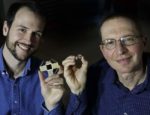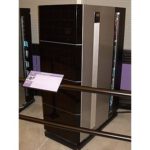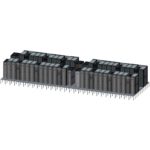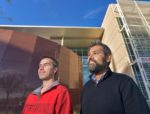Christian Trott from Sandia gave this talk at the GPU Technology Conference. “The Kokkos C++ Performance Portability EcoSystem is a production-level solution for writing modern C++ applications in a hardware-agnostic way. We’ll provide success stories for Kokkos adoption in large production applications on the leading supercomputing platforms in the U.S. We’ll focus particularly on early results from two of the world’s most powerful supercomputers, Summit and Sierra, both powered by NVIDIA Tesla V100 GPUs.”
Sandia Powers Breakthroughs in Neuromorphic Computing
Researchers at Sandia National Laboratories have collaborated with Stanford University and University of Massachusetts, Amherst to address the challenges of neuromorphic computing, which mimics the way the human brain carries out data-centric tasks. The work has lead to recent breakthroughs in neuromorphic computing and the broader fields of organic electronics and solid-state electrochemistry.
Vintage Video: The Paragon Supercomputer – A Product of Partnership
In this vintage video, Intel launches the Paragon line of supercomputers, a series of massively parallel systems produced in the 1990s. In 1993, Sandia National Laboratories installed an Intel XP/S 140 Paragon supercomputer, which claimed the No. 1 position on the June 1994 TOP500 list. “With 3,680 processors, the system ran the Linpack benchmark at 143.40 Gflop/s. It was the first massively parallel processor supercomputer to be indisputably the fastest system in the world.”
Video: Arm in HPC
Brent Gorda from ARM gave this talk at the Rice Oil & Gas Conference. “With the recent Astra system at Sandia Lab (#203 on the Top500) and HPE Catalyst project in the UK, Arm-based architectures are arriving in HPC environments. Several partners have announced or will soon announce new silicon and projects, each of which offers something different and compelling for our community. Brent will describe the driving factors and how these solutions are changing the landscape for HPC.”
ASTRA: A Large Scale ARM64 HPC Deployment
Michael Aguilar from Sandia National Laboratories gave this talk at the Stanford HPC Conference. “This talk will discuss the Sandia National Laboratories Astra HPC system as mechanism for developing and evaluating large-scale deployments of alternative and advanced computational architectures. As part of the Vanguard program, the new Arm-based system will be used by the National Nuclear Security Administration (NNSA) to run advanced modeling and simulation workloads for addressing areas such as national security, energy and science.”
Sandia steps up to New Quantum Computing Projects
Sandia National Laboratories researchers are looking to shape the future of computing through a series of quantum information science projects. As part of the work, they will collaborate to design and develop a new quantum computer that will use trapped atomic ion technology. “Quantum information science represents the next frontier in the information age,” said U.S. Secretary of Energy Rick Perry this fall when he announced $218 million in DOE funding for the research.
LANL Solicits Bids for 18 MW Crossroads Supercomputer for Delivery in 2021
The next big supercomputer is out for bid. An RFP was released today for Crossroads, an 18 Megawatt system that will support the nation’s Stockpile Stewardship Program. “Los Alamos National Laboratory is proud to serve as the home of Crossroads. This high-performance computer will continue the Laboratory’s tradition of deploying unique capabilities to achieve our mission of national security science,” said Thom Mason from LANL.”
ARM goes Big: HPE Builds Petaflop Supercomputer for Sandia
Today HPE announced plans to deliver the world’s largest Arm supercomputer. As part of the Vanguard program, Astra, the new Arm-based system, will be used by the NNSA to run advanced modeling and simulation workloads for addressing areas such as national security, energy and science. “By introducing Arm processors with the HPE Apollo 70, a purpose-built HPC architecture, we are bringing powerful elements, like optimal memory performance and greater density, to supercomputers that existing technologies in the market cannot match,” said Mike Vildibill, vice president, Advanced Technologies Group, HPE.
Let’s Talk Exascale: Making Software Development more Efficient
In this episode of Let’s Talk Exascale, Mike Heroux from Sandia National Labs describes the Exascale Computing Project’s Software Development Kit, an organizational approach to reduce the complexity of the project management of ECP software technology. “My hope is that as we create these SDKs and bring these independently developed products together under a collaborative umbrella, that instead of saying that each of these individual products is available independently, we can start to say that an SDK is available.”
Let’s Talk Exascale: Transforming Combustion Science and Technology
In this episode of Let’s Talk Exascale, Jackie Chen from Sandia National Laboratories describes the Combustion-Pele project, which uses predictive simulation for the development of cleaner-burning engines. “Almost all practical combustors operate under extremely high turbulence levels to increase the rate of combustion providing high efficiency, but there are still outstanding challenges in understanding how turbulence affects auto-ignition.”












